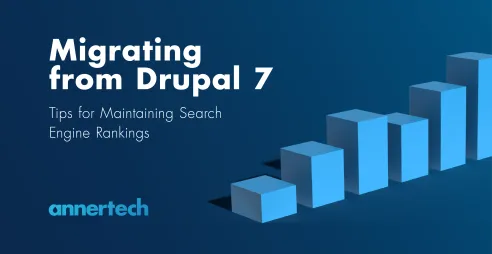Annertech's Technical SEO Service for Drupal Websites

Your technical SEO strategy ensures that your content is found by Google and presented in social channels wearing its finest outfit. If yours doesn't, let us help make your website the belle of the SEO ball.
Search Engine Optimisation (SEO) is all about "writing great content". Except, it’s not all about "writing great content". All the great content in the world won’t help your search engine rankings and digital marketing strategy if the content can’t be understood by Google, Facebook, and the others.
Before you get to the “writing great content” phase, you need to have the technical infrastructure in place to ensure that this content is easily consumed by automated technologies such as search engines and social media platforms. This aspect of SEO is what we call "Technical SEO".
Let’s look at it under 4 headings:
- Automated Testing
- Meta Tags and Metadata
- Performance & Mobile Optimisation
- Analytics and Goals
Automated Testing
This is the most basic part. We run a suite of automated tests to find all the low-hanging fruit to fix. But make no mistake, just because it's low hanging, easy to fix fruit, it's what is perhaps most damaging to your search engine rankings. During this phase we are testing for things such as:
- Sitemaps - the presence of a sitemap file on your site will help search engines better understand your site's structure and find where pages are located
- Broken links - you don’t want someone clicking on a link to your product only to be told that page doesn’t exist anymore
- Missing alt tags - alt tags are very important to help screen-readers and visually-impaired users understand what is being presented in the images on your site. They are also used when an image doesn’t load (for example the image file was removed, but the page not updated)
- Meta tags - you need to make sure that machines can understand your metadata, and, thus, use it as your want them to
- H1 - It’s important to have a unique main heading for each page on your website, and also important to make sure there is only one main heading on the page (you can have multiple subheadings)
- Canonical URL - if your content can be found in a number of different places on your website or around the web, ensure that one version is set as the canonical version, so search engines know where to look to see if the content is ever updated and so you don't get penalised by Google for duplicate content
- SSL Certificate - all website traffic should be served over secure (encrypted) protocols. You can imagine the crisis if someone was making a purchase on your website and someone else could intercept it to steal their credit card information
- Robots.txt - having an incorrectly configured robots.txt file can seriously impact your website’s performance in search results, simply because it may be instructing search engines to not index parts or all of your site
Meta Tags and Metadata
Technical SEO implementation begins with setting up your content management system (CMS) in such a way that makes it easy for Google, Facebook, et al to find, index, and present your content to the world. Once set up, much of the metadata work is then automated, with you just needing to override options where you wish to.
Let’s look at a three-pronged approach to this:
- Basic: At a basic level, the fundamental meta tag fields are enabled. These include fields for page title, meta description, canonical URL, language and others
- Intermediate: Once the fundamental tags are in place, we can then add extra fields for social sharing and search engine displays. These fields include protocols for Twitter and Open Graph. Open Graph is what is used by Facebook, LinkedIn, WhatsApp, Pinterest, and many more. These more complex meta tags are then used to tell search engines and social media platforms what image, title, text, call to action, links, etc you want them to use when displaying your webpage. Ever put a link to your website on Facebook and the image that gets used is your logo instead of an image from the article? This makes sure that doesn’t happen any more
- Advanced: At this stage, your site is well set up for content findability, but let’s take it one step further. Now, let's add meta tag fields for Schema.org protocols. These are the meta tags that define the type of page someone is looking at; whether it's a blog or product; if it has a price or special offer; if the author of the page can be found on LinkedIn or other social media; if there are any reviews and how many stars it gets; etc. Schema protocols are used all over the world to present data in interesting manners. You know when you search for a recipe and see a carousel of recipes at the top of your Google search result page? That’s powered by schema.org meta tags. Same with the “People also searched for” accordions you see. Basically, if you want to get your content to "Position Zero" in Google, you need to work with Schema.org meta tags
You can see examples of all of these meta tags by clicking "View Source" for this web page.
Performance & Mobile Optimisation
Research shows that users prefer sites with a great page experience, and search engines, such as Google, are taking that into consideration when calculating the page rank for your page. Technical SEO is no longer just about metatags and correctly configured robots.txt, and while still important, other factors such as how quickly pages load and mobile-friendliness now also can have an impact on your site's SEO performance.
Given the inevitable impact of speed on both SEO and conversion rates, it is therefore critical that your site is both fast and provides a good mobile experience, and time should be taken to optimise your site in both of these areas.
Analytics and Goals
Okay, your site has been checked by our automated tools. Any issues found have been fixed. Your metadata strategy is in place and anything you post on social media looks just how you’d like it to. Next let’s start analysing the data.
Here we ensure that you are registered with Google Analytics, Search Console, Places, and Business. Once done, we then set up goals and funnels in Google Analytics to define what you want to achieve with your digital marketing strategy - more conversions, more donations through your monthly donation form, more sales of the latest product in your online store, etc.
We can track all these things and much more, so your marketing department can see exactly what is working and what needs tweaking.
When your technical SEO infrastructure is ready, then you can get to work on "writing great content".
We'll be covering this in another blog post soon, so stay tuned!

Climb Up the SEO Ladder
Get in contact for a Technical SEO audit, so your website is primed for great content findability.
Get in Touch

